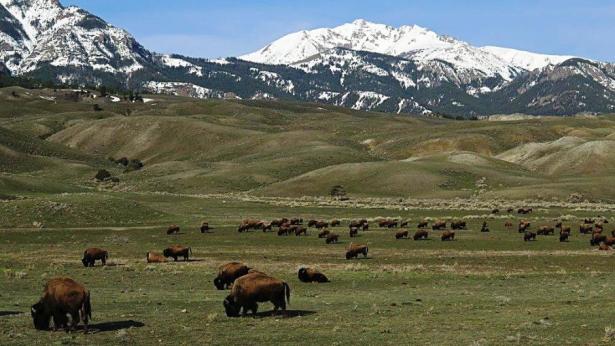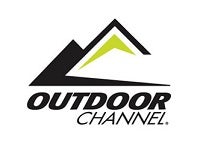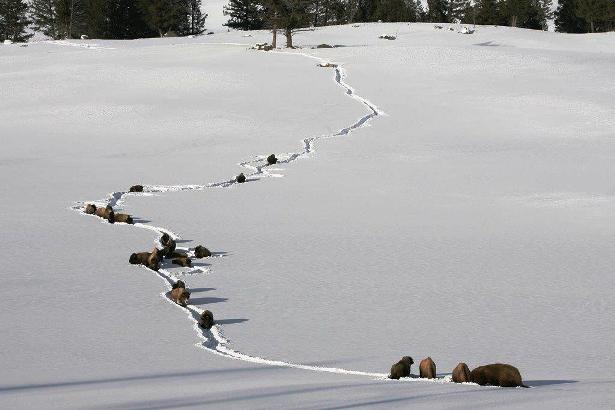Hot-Button Bison
OutdoorChannel.com 05.13.14

By: Posted 05-08-2014 OutdoorChannel.com in News by Steve Rogers
Permitted use provided by: OutdoorChannel.com.
The American bison is undeniably one of this country’s greatest conservation stories, and one of the most significant buffalo herds is at Yellowstone National Park.
And while hunting is one of the tools park officials use to regulate the herd, they say don’t expect hunting inside the park boundaries to ever be legalized, despite ongoing efforts and reports to the contrary.
“That will probably never happen,” Yellowstone spokesman Dan Hottle said. “The volcano will probably go off before there is bison hunting inside the park.”
But it continues to be a hot-button political issue at the park, which covers 2.2 million acres mostly in Wyoming but also stretches into Montana and Idaho.
Marty Zaluski, the Montana state veterinarian and a member of a federal, state and tribal team that oversees bison in and around Yellowstone, said he is in favor of opening the park for limited hunting.
“I don’t have rose-colored glasses, but I see many potential benefits to hunting in the park,” he said.
Rep. John F. Lacey, a champion conservationist from Iowa, authored the first version of his Lacey Act in 1894 and it banned hunting or killing of animals inside the park unless they were threatening injury or death to humans.
Tens of millions buffalo roamed the plains west of the Mississippi River until systematic hunting in the late 1800s drove the species to near extinction.
Approximately two dozen buffalos remained at Yellowstone in 1902. From that small herd has grown the two large herds now occupying the park. Yellowstone bison now represent the best example for preservation of wild plains bison in North America.
The Lacey Act and the hunting ban are part of the 142-year-old Yellowstone National Park’s original principles.
“We’re about preservation and protection of those animals once they’re inside our boundary,” Hottle said.
But once they leave the boundary, they’re not (under) our jurisdiction any more. Same thing with the wolves. The wolves aren’t so much migratory, but they’re territorial and they have big territories. Once they step outside the park, they’re legally hunted.”
Hunting outside the park, however, is encouraged and is one of the chief tactics used to limit herd size.
“(Hunting) is probably the major tool we use, just not inside the park,” Hottle said. “This year we have about 600 bison that we need to remove from the population. That doesn’t really have anything to do with Yellowstone not being able to handle those bison. It’s just more to do with political pressure from outside the state of Montana because of the threat of brucellosis.”
Montana ranchers fear the spread of brucellosis, an infectious disease caused by bacteria, from the bison to their cattle herds when the buffalo wander outside the park in winter. The park has an agreement with Montana to limit the size of its herd to around 3,500.
Yellowstone works with Montana Fish, Wildlife and Parks, Hottle said, and each year hunters take buffalo outside the north boundary and west boundary of the park. The majority are taken by Native American tribes who have hunting rights granted in 19th century treaties with U.S. government.
“Most of the hunting takes place with the treaty hunts with the tribes,” Hottle said. “They get the bulk of the bison. They took about 250 or so (last season). State hunters took about another 100.”
In past years, additional bison were rounded up outside the park and taken to slaughter facilities. This year, however, they were transferred to the tribes.
“We have a holding facility outside the north entrance,” Hottle said. “If we get an ample opportunity, we guide them into the capture facility. Periodically, the tribes would come, trailer them up and take them to their own slaughter facilities. There are about 50 tribes across the country that are part of a consortium that receives the meat.”
Zaluski said hunting of buffalo inside the park would protect cattle that graze in Montana near Yellowstone and would also help bring the herd, estimated earlier this year to number approximately 4,600, closer to the population target of 3,000 to 3,500.
“What I’m saying here is we have the potential to move this intractable issue forward,” he said. “Hunting needs to be looked at more seriously as a possible solution.”
Hottle said work will continue to help regulate the bison numbers, but he doesn’t think anything will change with the park’s borders.
“That’s a Congressional decision, one that will probably never happen,” he said. “It’s an ongoing daily issue with us. It never really dies down.”

